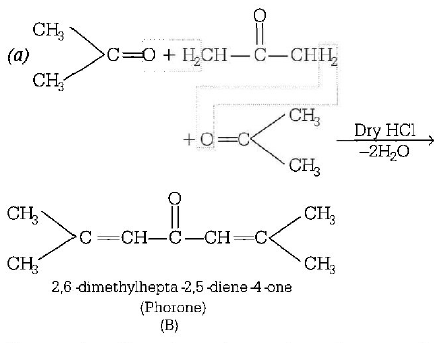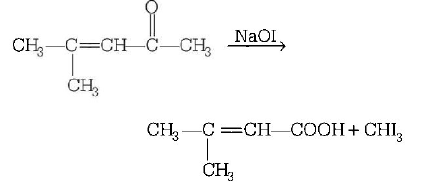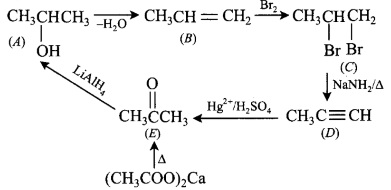1.
\[\underset{\left( A \right)}{\mathop{3C{{H}_{3}}COC{{H}_{3}}}}\,\xrightarrow[-{{H}_{2}}O]{HCl}\] $${\left( {C{H_3}} \right)_2}C = CH - \mathop {CO}\limits_{\left( B \right)} - CH$$ $$ = C{\left( {C{H_3}} \right)_2}$$
This polymer $$(B)$$ is obtained when acetone is saturated with $$HCl$$ gas, $$B$$ can be
A
phorone
B
formose
C
diacetone alcohol
D
mesityl oxide
Answer :
phorone
2. $${\left( {C{H_3}} \right)_2}C = CHCOC{H_3}$$ can be oxidised to $${\left( {C{H_3}} \right)_2}C = CHCOOH$$ by
A
$${\text{chromic acid}}$$
B
$$NaOI$$
C
$$Cu\,\,{\text{at}}\,\,{300^ \circ }C$$
D
$$KMn{O_4}$$
Answer :
$$NaOI$$
3. Which of the following compounds will undergo self aldol condensation in the presence of cold dilute alkali?
A
$$CH \equiv C - CHO$$
B
$$HCHO$$
C
$${C_6}{H_5}CHO$$
D
$$C{H_3}C{H_2}CHO$$
Answer :
$$C{H_3}C{H_2}CHO$$
4.
Identify $$(X), (Y)$$ and $$(Z)$$ reagents in the given sequence of reactions.
\[CH\equiv CH\xrightarrow{X}C{{H}_{3}}CHO\] \[\xrightarrow{Y}C{{H}_{3}}CH\left( OH \right)C{{H}_{3}}\] \[\xrightarrow{Z}C{{H}_{3}}COC{{H}_{3}}\]
A
$$X = {H_2}S{O_4},Y = \frac{{{H_2}O}}{{O{H^ - }}},$$ $$Z = PC{l_5},{\text{heat}}$$
B
$$X = HN{O_3},Y = N{a_2}C{O_3},$$ $$Z = {H_2}S{O_4},{\text{heat}}$$
C
$$X = \frac{{{H_2}S{O_4}}}{{H{g^{2 + }}}},Y = \frac{{PC{l_5}}}{{{H_2}O}},$$ $$Z = \frac{{{K_2}C{r_2}{O_7}}}{{O{H^ - }}}$$
D
$$X = \frac{{{H_2}S{O_4}}}{{H{g^{2 + }}}},Y = \frac{{C{H_3}MgBr}}{{{H_2}O}},$$ $$Z = \frac{{{K_2}C{r_2}{O_7}}}{{{H^ + }}}$$
Answer :
$$X = \frac{{{H_2}S{O_4}}}{{H{g^{2 + }}}},Y = \frac{{C{H_3}MgBr}}{{{H_2}O}},$$ $$Z = \frac{{{K_2}C{r_2}{O_7}}}{{{H^ + }}}$$
5.
The major product in the following reaction is

A


B


C


D


Answer :


6.
Which of the following reagent$$(s)$$ used for the conversion ?

A
$${\text{glycol}}/LiAl{H_4}/{H_3}{O^ + }$$
B
$${\text{glycol}}/NaH/{H_3}{O^ + }$$
C
$$LiAl{H_4}$$
D
$$NaB{H_4}$$
Answer :
$${\text{glycol}}/LiAl{H_4}/{H_3}{O^ + }$$
7. 1 - Phenylethanol can be prepared by reaction of benzaldehyde with
A
methyl bromide
B
ethyl iodide and magnesium
C
methyl bromide and aluminium bromide
D
methyl iodide and magnesium
Answer :
methyl iodide and magnesium
8. An alcohol $$(A)$$ on dehydration gives $$\left( B \right)$$ which adds bromine molecule to give $$(C).$$ $$(C)$$ on heating with sodamide gives $$(D)$$ which on hydration in the presence of $$\frac{{H{g^{2 + }}}}{{{H_2}S{O_4}}}$$ gives $$(E).$$ $$(E)$$ on reduction by lithium aluminium hydride gives $$(A).$$ $$(E)$$ is also obtained on dry distillation of calcium salt of acetic acid. How many enolisable proton present in the product $$(E)?$$
A
2
B
6
C
3
D
0
Answer :
6
9.
Arrange the following in order of decreasing acidity

A
C > A > B
B
C > B > A
C
A > C > B
D
A > B > C
Answer :
C > A > B
10. When propanal reacts with 2-methylpropanal in presence of $$NaOH,$$ four different products are formed. The reaction is known as
A
aldol condensation
B
cross aldol condensation
C
Cannizzaro reaction
D
$$HVZ$$ condensation
Answer :
cross aldol condensation

 unit so it can be oxidised to $${\left( {C{H_3}} \right)_2}C = CH - COOH$$ by $$NaOI.$$
unit so it can be oxidised to $${\left( {C{H_3}} \right)_2}C = CH - COOH$$ by $$NaOI.$$


 is a \[{{2}^{\circ }}\] alcohol and can be prepared by the reaction of benzaldehyde with Grignard reagent \[C{{H}_{3}}MgI.\]
is a \[{{2}^{\circ }}\] alcohol and can be prepared by the reaction of benzaldehyde with Grignard reagent \[C{{H}_{3}}MgI.\] 
